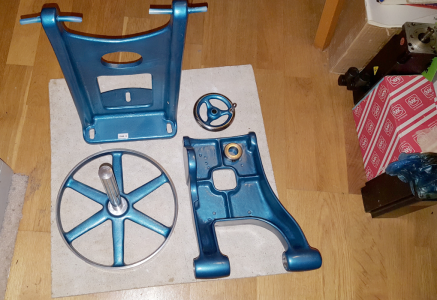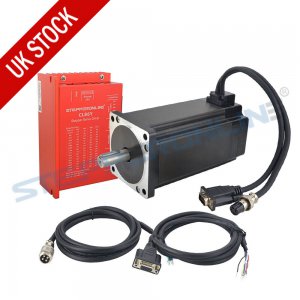-
Welcome back Guest! Did you know you can mentor other members here at H-M? If not, please check out our Relaunch of Hobby Machinist Mentoring Program!
You are using an out of date browser. It may not display this or other websites correctly.
You should upgrade or use an alternative browser.
You should upgrade or use an alternative browser.
Helical milling
- Thread starter DavidR8
- Start date
- Joined
- Oct 29, 2014
- Messages
- 354
I would like to pursue this. If any member here can identify the hardware / software required please chime in. The pulleys, brackets, belts and dividing head I can handle . The stepper motor, encoder and logic to drive it is what I will need help with. Thanks in advance for your help
- Joined
- Mar 26, 2018
- Messages
- 2,724
This project is a pseudo CNC one. First off you'll need a way to measure table travel. This will be a glass or magnetic scale, or at minimum an encoder on the handwheel. You'll then need a way to gear the motor on the dividing head to the signal from the encoder. Some stepper/servo systems can do this right out of the box. You'll need 2 things, a motor with quadrature input command (Step/Dir is standard, so not everything will accept quadrature) and configurable electronic gearing. I think most servos (including Clearpath and DMM Technology, the two most popular low cost servo platforms) will support this.
Alternatively, you can use a plain stepper motor and some microprocessor to read the encoder and produce the commanded motion to the stepper with the appropriate gear ratio. This also will give you more room to customize the design to include an operator interface. You will need to have some basic knowledge of microprocessor programming. An arduino would be more than sufficient for this application.
Finally, this is super easy to do on a CNC. even if only the rotary head was driven, you could use the scale feedback as a "jog pendant" input and that would handle gearing the motor to the encoder signal.
Alternatively, you can use a plain stepper motor and some microprocessor to read the encoder and produce the commanded motion to the stepper with the appropriate gear ratio. This also will give you more room to customize the design to include an operator interface. You will need to have some basic knowledge of microprocessor programming. An arduino would be more than sufficient for this application.
Finally, this is super easy to do on a CNC. even if only the rotary head was driven, you could use the scale feedback as a "jog pendant" input and that would handle gearing the motor to the encoder signal.
A lot would depend on the needs. You can adapt a stepper to drive a dividing head or rotary table easy enough. After that it's very similar to the ELS projects for threading on a lathe. You read the movement from the machine handles turning, then generate the stepper pulses you need to move the rotary axis. You could probably add some sort of interface to tell it how many turns per rotation of the leadscrew. So long as you are moving in the same direction, backlash isn't an issue. You might need to adjust for it when moving back to the start though.
Even better is using a scale like a DRO scale. That way you know the true table position, you aren't having to calculate it based on the leadscrew. It might even be possible to read the scale pulses and share it with the normal DRO. So long as your circuit doesn't mess up the pulses somehow.
I've thought about it, but I haven't taken the time to do anything with it as the only thing I can think of to make with it would be things like worm gears. Interesting, but I don't really need to make that sort of thing at the moment.
Even better is using a scale like a DRO scale. That way you know the true table position, you aren't having to calculate it based on the leadscrew. It might even be possible to read the scale pulses and share it with the normal DRO. So long as your circuit doesn't mess up the pulses somehow.
I've thought about it, but I haven't taken the time to do anything with it as the only thing I can think of to make with it would be things like worm gears. Interesting, but I don't really need to make that sort of thing at the moment.
- Joined
- May 27, 2016
- Messages
- 3,469
The servomotor used is from here.
--> https://www.quicksilvercontrols.com/shop/17-silvermax-23-frame-xt-series
I suppose a dividing head is a handy way to put a geared down chuck on a mill, but mounting a drive-able chuck can be done.
As indicated by the postings, CNC fans on this site would use a DRO output, and the motor encoder output (or stepper pulses), and count their way to making a helix.
One of those servomotors is getting on for half the price of my entire mill drill !

I do have a couple of (rather more powerful) servomotors with high resolution encoders. There they are lurking on the right side of the picture, sneaking in to steal the show for the South Bend bits restoration. These were salvaged rescue parts from an upgrade job. The video was interesting, and, of course, it was giving me ideas, but I think the mass produced stepper motors like the Nema 34 + Servo Drive electronics in the eBay offering (£126.10) seems a more cost effective choice if one wants to do this stuff.

One thing that the CNC guys always seem to do is replace the mill leadscrews with zero backlash ballscrews.
This is, of course, all well out of my league, but I loved the video!
--> https://www.quicksilvercontrols.com/shop/17-silvermax-23-frame-xt-series
I suppose a dividing head is a handy way to put a geared down chuck on a mill, but mounting a drive-able chuck can be done.
As indicated by the postings, CNC fans on this site would use a DRO output, and the motor encoder output (or stepper pulses), and count their way to making a helix.
One of those servomotors is getting on for half the price of my entire mill drill !

I do have a couple of (rather more powerful) servomotors with high resolution encoders. There they are lurking on the right side of the picture, sneaking in to steal the show for the South Bend bits restoration. These were salvaged rescue parts from an upgrade job. The video was interesting, and, of course, it was giving me ideas, but I think the mass produced stepper motors like the Nema 34 + Servo Drive electronics in the eBay offering (£126.10) seems a more cost effective choice if one wants to do this stuff.

One thing that the CNC guys always seem to do is replace the mill leadscrews with zero backlash ballscrews.
This is, of course, all well out of my league, but I loved the video!
Last edited:
- Joined
- Mar 26, 2018
- Messages
- 2,724
The servomotor used is from here.
--> https://www.quicksilvercontrols.com/shop/17-silvermax-23-frame-xt-series
I suppose a dividing head is a handy way to put a geared down chuck on a mill, but mounting a drive-able chuck can be done.
As indicated by the postings, CNC fans on this site would use a DRO output, and the motor encoder output (or stepper pulses), and count their way to making a helix.
One of those servomotors is getting on for half the price of my entire mill drill !
View attachment 351748
I do have a couple of (rather more powerful) servomotors with high resolution encoders. There they are lurking on the right side of the picture, sneaking in to steal the show for the South Bend bits restoration. These were salvaged rescue parts from an upgrade job. The video was interesting, and, of course, it was giving me ideas, but I think the mass produced stepper motors like the Nema 34 + Servo Drive eletronics in the eBay offering (£126.10) seems a more cost effective choice if one wants to do this stuff.
View attachment 351750
One thing that the CNC guys always seem to do is replace the mill leadscrews with zero backlash ballscrews.
This is, of course, all well out of my league, but I loved the video!
Ooooh, you know I love servos. Are those Kollmorgans? Did you get the drives and cables?
- Joined
- Nov 5, 2016
- Messages
- 1,419
I watched that video this morning and it is very cool! There certainly are limitations to this verses a horizonal hill with a drive train, but one of the more serious ones is that you can only use end mill type cutters; no circular wheel cutters, like an involute gear wheel cutter. On a compound horizonal mill you can rotate the table to provide clearance for the cutter. That is the sole reason for being able to rotate the table. It does NOT allow you to cut a taper as one might first think when learning this trade.
But, it certainly would be a fun thing to play with!
Ted
But, it certainly would be a fun thing to play with!
Ted
- Joined
- May 27, 2016
- Messages
- 3,469
The motors are SEM brand, rescued from duty driving a 6.1m LEO (Low Earth Orbit) precision satellite tracking Earthstation dish. The reason they became orphaned was because SEM were bought out by a German company which was taking up their entire production capability, so we had to seek out a alternative source. One is a High Response Servomotor, good to 8000RPM with 1.8Nm stall torque and can run 22A on a 350V bus. The fatter one is also 8000RPM, 3.5Nm stall torque, and can run 44A on a 320V bus. Unable to use on new designs, nobody wanted them anymore! I was bound to say "yes".Ooooh, you know I love servos. Are those Kollmorgans? Did you get the drives and cables?
I did also get the drives, and cables, but unfortunately, not the connectors (cut off and dumped at the site). I have since discovered which they are.
I also have the software control suite. They sit there, nagging at me, just begging to be put to good use. Becoming a VFD speed control for a restored South Bend 9 is not my idea of a being put to good use!
Unfortunately, much of my present machining interest is drooling at other HM member's projects! The damn pestilence bounced me straight into an already overdue retired status, and home situation outbuilding shop construction (COVID-delayed) will only get going maybe as Spring arrives. My (new) MT3 mill drill is still in it's crate. The vise and DRO are still in their shipping wrappers. There are boxes of stuff to be opened. Clamps, ER32 collet chuck set, parallels, cutters, the whole shebang.
The servomotors are still on the floor, imploring me to get some amps into them. For the present, what passes for machine interest stuff in the garage, is much more mundane
Last edited:

